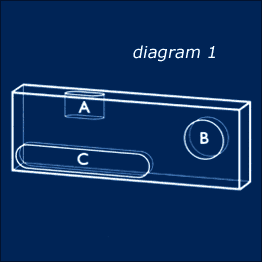Sample placement
EasySections have three wells (see diagram 1). labels1 Wells A and B are for paint samples; well C should be used for labelling in conjunction with well B. Well A is for use with a polishing wheel and produces a cross section which is thin enough for use with microscopes which have a short distance between objective and stage (biological microscopes). Well B is for cutting by hand but can also be used with a polishing wheel. Samples should be placed face up in the chosen well.

Sample labelling

A Rapidograph or other similar very fine indelible pen should be used. Labels can be written in well C directly on the cube or on a paper label. If using well A for samples, a paper label should be placed upside down in well C or alternatively, the label can be written on the face of the cube below well A.
Preparation of embedding resin
One drop of component B (dropper bottle) to 1ml of component A. In practice, mixing 2-3 ml at a time is the optimum amount. Stir carefully and leave to stand briefly to allow any air bubbles to rise. Further bubbles which form while putting the resin into the well should also rise by allowing the EasySection to stand. Use resin within 20 minutes. Resin must be at room temperature before mixing. Resin has a minimum shelf life of 1 year if stored in its container in dark below 20°C. Catalyst should be stored in dark below 25°C. NB The material safety data sheets, available on this site as printable PDF files (MATERIAL SAFETY DATA SHEET A, MATERIAL SAFETY DATA SHEET B) must be read before carrying out this procedure. In order to read these files you will need to have the Adobe Acrobat program installed.